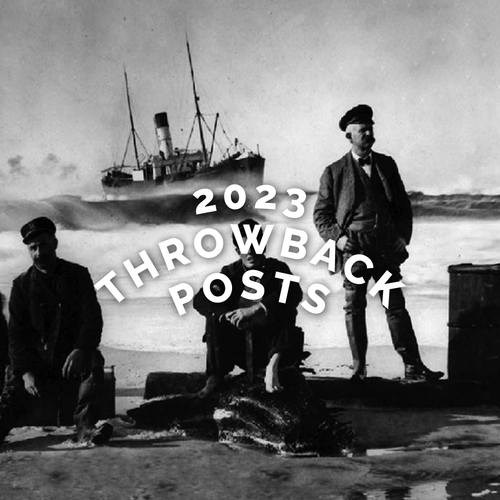
2023 #tbt
JAN - NAPEAGUE STATION
The Napeague Station House (USLSS Station 9) was designed and built in 1938. Originally located on the thin strip of land between the Atlantic Ocean and Gardiners Bay, the station was closed in 1947, but later moved by barge in 1954 to Star Island in Montauk. The operation took 6 months, with one winter storm grounding the barge on a sand bar for 2 months. Another year of construction and renovation lay ahead, and on October 1, 1955 the station was reopened as Coast Guard Station Montauk. In 1962, a cutter by the name of Point Wells was assigned to the station, which was responsible for a large drug bust off Gardiners Island years later.
FEB - SS SAVANNAH
In case you missed it earlier in the week, @NEWSDAY published a fantastic article about the recent discovery of a (potential) piece of the SS Savannah, a very significant ship that ran aground on Fire Island in 1821. The SS Savannah was built in 1918 at the New York shipyard of Fickett and Crockett, and was converted to an auxiliary steamship before its completion. After a brief tour down south, in which President James Monroe took an excursion on the ship, the SS Savannah embarked on May 24, 1819 on the first steam powered transatlantic voyage. After 29 days, the ship arrived at Liverpool, but only used the steam engines for about 80 hours of the voyage. After returning to the states, the SS Savannah was converted back into a sailing packet, as the steam powered trip was not successful, and began running cargo up and down the eastern seaboard. She ran aground on November 5th, 1821. A large piece of the (supposed) ship is now at the base of the light house.
MAR - SS GLUCKAUF
The SS Gluckauf [German for 'good luck'] was another historic ship that has wound up on the shores of Long Island. Built in 1885 in Newcastle upon Tyne, it was the first true oil tanker to take to the seas. Previously, ships would take oil in the form of barrels or drums, but the Gluckauf held compartments in which oil could be pumped directly into. Longshoremen and oil workers boycotted the ship, so much so that it was given police protection. Gluckauf ran aground on March 25, 1893 on the offshore bar near Blue Point. The crew was rescued via breeches buoy, and the ship became a popular tourist attraction.
APR - BALD HILL SKI BOWL
We had a rather mild winter on the Island, but believe it or not, there was once a time when you could ski here. Bald Hill Ski Bowl in Farmingville was built in 1964 on 74 acres, and saw upwards of 5,000 visitors a week during its most popular seasons in the 70s. The hill featured 3 runs, one for beginners, one for intermediates, and a real calf-burner of a run for the experts, at 1,400 feet long. The cost for a day of skiing was $2.25. Decreasing snowfalls lead to their lowest attendance in 1980, where the slopes were only open for 8 days. That season, they drew the same amount of people they would draw in a single day. The overhead T-Bar shut down for good after that season, and the 200 vertical feet is now the area around the Brookhaven Amphitheater.
MAY - GREAT SOUTH BAY CLAMMERS
The Great South Bay was once home to over 6,500 commercial shellfishermen. In the early 1900s, as many as 100,000 barrels of oysters were being shipped from the waters, and in the 1970s, 50% of the hard clams in the United States were farmed there [New York provided 60% overall]. It was said that the plentiful amount of shellfish could filter all of the Great South Bay in less than 3 days. Numbers have dramatically decreased, and you can no longer ‘walk across the bay by going boat to boat’. Algal blooms, fueled by nitrogen pollution, and decreasing water quality are the main culprit. In the 90s, when the population was lowest, it could take nearly 100 days to filter the same amount of water. Each spring, a million juvenile clams are grown, and released later in the fall in an ongoing effort to reseed the bay.
JUN - VINCENZO BONANNO
The Vincenzo Bonanno was an Italian Steamer bound for New York Harbor. Its cargo contained general merchandise, but the bulk of the load was lemons. The vessel ran aground on a sandbar in a heavy fog on June 17, 1906 off Point O’Woods. In an attempt to lighten the ship, the crew tossed most of the items overboard, much to the delight of local residents, as lemons floated up on the shore for days afterwards. It took 10 days and 4 station crews to refloat the vessel. Pictured here [left to right] are station mascot “Major”, father and son duo from the Life Saving Station, Charles and Ben Baker, and wreck master Ben Dunbar. This photo was taken the day after the Vincenzo Bonanno ran aground, June 18, 1906.
JUL - R-34
While not as famous or glamorous as Lindbergh’s crossing, the R.34 was the first rigid airship to make a transatlantic crossing, and the first aircraft to make a return trip as well. Originally developed for use in World War I, but never seeing action, it was decided that the R.34 would make the crossing on July 2, 1919. It was not intended to be a passenger ship, and as such, hammocks were slung up in the keel walkways, and a metal plate was attached to an exhaust pipe to serve as a cooking area. R.34 landed on July 6, 1919 in Mineola, after 108 hours of flight with virtually no fuel left. The crew had no training in landing large airships, so Major E.M. Pritchard of the Royal Naval Air Service jumped by parachute to the ground, becoming the first European to reach American soil by air. The R.34 returned to RNAS Pulham on July 10, 1919.

AUG - BATTLE OF LONG ISLAND
The Battle of Long Island, also known as the Battle of Brooklyn, was the first major battle to take place during the American Revolutionary War after the US declared its independence in July of 1776. After a victory in Boston of March that year, General George Washington moved his army to defend the port of New York, as he knew the harbor would provide a strategic base for the Royal Navy. Initially landing on Staten Island, the Royal Navy was reinforced for over a month, and on August 22 crossed to Gravesend Bay, flanking the Americans. On August 26, the first shots of the Battle of Long Island were fired near the Red Lion Inn near present day 39th Street and 4th Avenue, and the resulting battle was the largest fought in the Revolutionary War. The British ultimately defeated the Continental Army and gained access to the Port of New York for the remainder of the war.
SEP - GROVERBUILT
On September 3, 1985, Al Grover became the first person to cross the Atlantic Ocean in an outboard powered boat. Grover, a WWII Paratrooper, moved to Freeport and opened High and Dry Marina, selling popular power boats while producing his own fiberglass Groverbuilt boats. “Well, I crossed the Pacific in a troop carrier, but I never crossed an ocean in my own boat. That got to me.” Originally planned with two boats, on the initial trailering to Newfoundland one of the boats lost control on the road and was damaged beyond repair. On August 1, the journey began. Grover and his son endured gale force winds, Grover falling overboard [without a life jacket] and 25 foot swells from Hurricane Claudette. On September 3, the 26 foot fiberglass boat arrived at Lisbon, Portugal, traveling over 3000 miles.

OCT - CAMP WIKOFF
In the summer of 1898, Theodore Roosevelt and his Rough Riders found themselves at Camp Wikoff, a makeshift quarantine camp in Montauk. This marked a crucial moment in American history as they returned from the Spanish-American War, but not without facing a unique challenge; quarantine. After their heroic exploits in Cuba during the war, the Rough Riders were placed under quarantine to prevent the spread of Yellow Fever.

The Camp struggled to catch up with the ever increasing numbers of sick troops, some 10,000 troops were treated in thirty days and the camp contained over 21,000 troops at one time. Despite the adversity they faced, the Rough Riders embraced their time at Camp Wikoff, where they engaged in drills and even entertained themselves with impromptu baseball matches. Troops were processed out as soon as possible and the last unit left the camp on October 28, 1898 and the camp was abandoned.
NOV - FIRE ISLAND LIGHT
The Fire Island Lighthouse celebrated its 165th birthday on November 1st. The current tower was a replacement for the original one, which stood 74 feet high. In 1857, congress allocated $40,000 for the construction of a new tower at 168 feet high. It was lit in 1858. The lighthouse got its signature daymarks in 1891. This is a vintage postcard from our personal collection that will be used for some upcoming marketing materials in the new year.
DEC - FLYING SANTA
On December 17, 1953 Edward Rowe Snow, aka “The Flying Santa” flew over the Fire Island Lighthouse, delivering gifts to the residents. What started in 1929 became a yearly tradition for William Wincapaw, a Maine pilot who would often fly in hazardous conditions, using the beacons from lighthouses as a means of navigation on his way to help others. On Christmas Day, Wincapaw loaded his plane with newspapers, magazines, coffee and candy and delivered them via air to the lights in the Rockland area. They were simple gifts, but meaningful to the keepers who often lived in remote places. In 1936, Wincapaw enlisted the help of Snow to help with the ever increasing number of lighthouses that would receive gifts. After Wincapaws death in 1947, Snow decided to keep the tradition alive. In 1953, Snow made his first and only Fire Island visit, leaving gifts for the keeper Gottfried Mahler and his family. Sadly, no photos exist [please provide if they do!]

